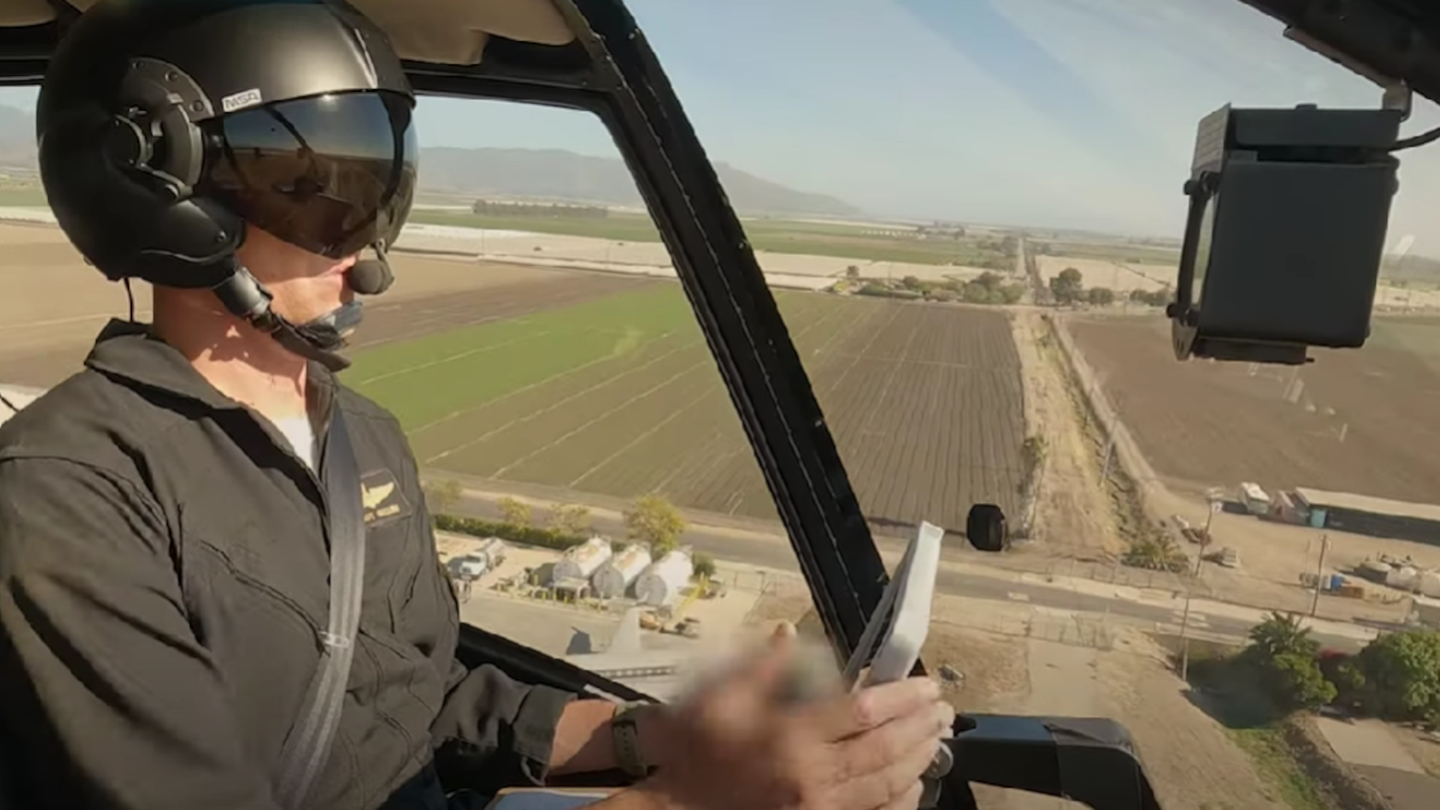Skyryse’s Automated Autorotation Tech Lands Guinness World Record
The aviation technology startup completed the first fully automated autorotation for an emergency landing, using a tech-equipped Robinson R66.

The only thing Skyryse test pilots touched during July’s fully automated autorotation was a small tablet in the cockpit. [Courtesy: Skyryse]
A Los Angeles-area startup angling to simplify the cockpit for pilots—and which has already taken nonpilots such as Emmy award-winning actor Jon Hamm and U.S. Representative Julia Brownley (D-Calif.) to the skies—just broke serious ground.
Aviation software and safety technology firm Skyryse this week announced it completed the world’s first fully automated autorotation procedure for an emergency landing—a feat certified by Guinness World Records. The flight took place on July 22 with a Skyryse-equipped Robinson R66 single-engine helicopter.
“Every year, more than 400 people lose their lives in general aviation accidents just in the United States alone,” said Mark Groden, founder and CEO of Skyryse. “Fully automated autorotation is just one example of how our technology will bring a commercial grade of safety and beyond to general aviation.”
Skyryse said it has completed “dozens” of automated autorotations. But until a few months ago, none were completely human-free. That changed in July, when the Skyrise-equipped R66 descended gently from altitude to the ground at the company’s Los Angeles-area flight test and performance facility. The helicopter’s two pilots simply sat back and watched.
Skyryse says its goal is to save lives when the engine cuts by bringing commercial-level safety to GA. The company’s autorotation technology is one of many safety features included in its universal cockpit (formerly called FlightOS) that will come standard on all Skyryse technology-equipped aircraft.
According to the Aircraft Owners and Pilots Association (AOPA), noncommercial helicopter accidents have held relatively steady over the past decade at around 80 to 100 per year. While more common than other aviation accidents, that figure is still relatively low. Perhaps the most high-profile case is the tragic death of basketball legend Kobe Bryant, his daughter, and seven other passengers aboard a Sikorsky S-76B that went down near Los Angeles in 2020.
But per the AOPA, 76 of the 87 noncommercial helicopter accidents in the U.S. in 2021—about 87 percent—were pilot-related. Maneuvering and rotorcraft aerodynamics were cited as the cause for nearly half of them.
Though July’s autorotation used a helicopter, Skyryse said its system could be equipped on any aircraft. The startup claims it has the first and only solution that works with the pilot to manage complex emergency procedures, such as engine failure, using a “reimagined” human-machine interface. The two leading causes of GA accidents between 2012 and 2021 according to the National Transportation Safety Board? Powerplant failure and loss of control in flight.
How Automated Autorotation Works
In the rare case of an emergency engine failure, Skyryse wants to take the pressure off the pilot’s plate.
In a manual autorotation, there are typically four steps. The first and most pivotal is the entry, which includes three maneuvers that must be performed in quick succession: down collective, aft cyclic, and pedal input. If the engine fails, a pilot has only about two seconds to get the collective down—otherwise, drag can cause the blade to stall, removing lift entirely.
“If you did nothing, the rotor would stop, and the aircraft would fall out of the sky like a rock,” said Skyryse test pilot Jason Trask.
Next is the glide phase, during which the pilot needs to maintain air speed, trim, and rpm, making constant, tiny adjustments. Then comes the flare, where the pilot pulls the aft cyclic to slow the aircraft down, leveling it as it approaches the ground.
And finally, there’s the landing: a pullup on the collective and the application of pedal inputs to keep the aircraft in trim, both at the same time. It’s an oft-practiced procedure in rotorcraft training because of the necessity to get it right.
With its built-in-house, redundant flight controls and suite of sensors, the Skyryse system can recognize power failures as they happen. This kicks off a series of automated procedures: lowering pitch, aligning the nose, maintaining level flight, completing the flare maneuver, and landing at the pilot’s desired location. Throughout all of this, the pilot will press a single button.
As of June, Skyryrse has been running a daily flight test campaign with its retrofitted R66, which follows testing with a piston-powered Robinson R44 since 2018. The turbine-powered R66 is the design the company plans to use to achieve an FAA supplemental type certification for its universal cockpit.
In February, Skyryse’s system reached 100 percent means of compliance with the FAA, which the company said marked a significant advance in its certification. Ground and flight testing represent the next major hurdles.
In March, Skyryse said it plans to sell a retrofitted R66 as the first single-pilot, fly-by-wire, vertical takeoff and landing (VTOL) aircraft with IFR certification and capabilities. In its view—and that of many competitors in the space—IFR will be essential for keeping urban air mobility (UAM) aircraft in the air. The firm said Thursday that it expects to unveil the first production helicopter equipped with its tech early next year.
And last month, Skyryse announced the delivery of the first Airbus H130 helicopter from partner Air Methods. It will be integrated with Skyryse tech as part of a 2022 partnership to retrofit 400 rotorcraft and fixed-wing aircraft. Air Methods’ fleet also includes single-engine helicopters such as the Airbus H125 and Eurocopter EC130 and AS350, as well as fixed-wing designs such as the Pilatus PC-12.
Like this story? We think you'll also like the Future of FLYING newsletter sent every Thursday afternoon. Sign up now.

Sign-up for newsletters & special offers!
Get the latest FLYING stories & special offers delivered directly to your inbox






